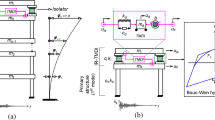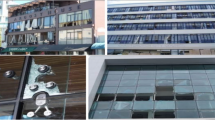Abstract
Glazing facades generally represent one of the most critical building components, from a structural point of view, since providing a physical separation and barrier for the building occupants. In this regard, especially under the action of extreme loads, they require specific design concepts voted to protect the building occupants. In this paper, the feasibility and potential of special mechanical connectors interposed at the interface between a given multi-storey primary building structure and the glazing facade are investigated via accurate finite-element models, under the action seismic and explosive loads. Given the case study of a 4-storey steel framed structure enclosed by a glazing curtain wall, both the global and local effects and potential benefits due to additional vibration control systems (VCSs) are preliminary assessed via numerical simulations, giving evidence of the activation—once properly designed—of a distributed-tuned-mass damper (TMD) concept involving the glass facade as a structural component of the 3D building. Differing from traditional TMD applications in civil engineering systems—namely consisting of lumped mass, damping and stiffness terms—these beneficial contributions are derived from the enclosing glass panels. Taking advantage of earlier research studies, in particular, where major efforts have been spent for the potential of visco-elastic VCSs, careful consideration is paid in this paper for the feasibility of elasto-plastic (PL) connectors, giving evidence of their response and effects under both seismic events and explosions. As shown from FE results partly discussed in the paper, the full 3D assembly can take benefit from the proposed design concept, hence suggesting the further development of the explored passive mitigation tool for the protection of the primary building structure.












Similar content being viewed by others
References
Bedon, C., Amadio, C., Sinico, A.: Numerical and analytical investigation on the dynamic buckling behavior of glass columns under blast. Eng. Struct. 79, 322–340 (2014)
Bedon, C., Amadio, C.: Enhancement of the seismic performance of multi-storey buildings by means of dissipative glazing curtain walls. Eng. Struct. 152, 320–334 (2017a)
Bedon, C., Amadio, C.: Passive control systems for the blast enhancement of glazing curtain walls under explosive loads. Open Civ. Eng. J. 11(suppl–1, M8), 396–419 (2017b)
Bedon, C., Amadio, C.: Numerical assessment of vibration control systems for multi-hazard design and mitigation of glass curtain walls. J. Build. Eng. 15, 1–13 (2018)
Bedon, C., Zhang, X., Santos, F., Honfi, D., Kozlowski, M., Arrigoni, M., Figuli, L., Lange, D.: Performance of structural glass facades under extreme loads—design methods, existing research, current issues and trends. Constr. Build. Mater. 163, 921–937 (2018)
Behr, R.A., Belarbi, A., Brown, A.T.: Seismic performance of architectural glass in a storefront wall system. Earthq. Spectra 11(3), 367–391 (1995)
Ber, B., Premrov, M., Sustersic, I., Dujic, B.: Innovative earthquake resistant timber-glass buildings. Nat. Sci. 5(8A), 63–71 (2013). https://doi.org/10.4236/ns.2013.58A1008
Chopra, A.K.: Dynamics of Structures-Theory and Applications to Earthquake Engineering, 4th edn. Prentice Hall, Englewood Cliffs (2011)
EN 1991-1-1: Eurocode 1—Actions on structures—Part 1–1: General Actions. CEN, Brussels, Belgium (2004)
EN 1993-1-1: Eurocode 3—Design of steel structures—Part 1–1: General rules and rules for buildings. CEN, Brussels, Belgium (2004)
EN 1998-1-1: Eurocode 8—Design of structures for earthquake resistance—Part 1: General rules, seismic actions and rules for buildings. CEN, Brussels, Belgium (2004)
Feldmann, M., Kasper, R., Abeln, B., Cruz, P., et al.: Guidance for European structural design of glass components—support to the implementation, harmonization and further development of the Eurocodes. In: Dimova, P., Feldmann, D. (eds.) Report EUR 26439, Joint Research Centre—Institute for the Protection and Security of the Citizen (2014). https://doi.org/10.2788/5523
GSA-TS01: Standard test method for glazing and window systems subject to dynamic overpressure loadings. US General Services Administration (2003)
Han, Q., Jia, J., Xu, Z., Bai, Y., Song, N.: Experimental evaluation of hysteretic behavior of rhombic steel plate dampers. Adv. Mech. Eng. Article ID 185629 (2014). https://doi.org/10.1155/2014/185629
Hejazi, F., Zabihi, A., Jaafar, M.S.: Development of elasto-plastic viscous damper finite element model for reinforced concrete frames. Solid Dyn. Earthq. Eng. 65, 284–293 (2014)
Kanitkar, R., Harms, M., Crosby, P., Lai, M.L.: Seismic retrofit of a steel moment frame structure using viscoelastic dampers. J. Earthq. Technol. 4, 207–219 (1998)
Iervolino, I., Galasso, C., Cosenza, E.: REXEL: computer aided record selection for code-based seismic structural analysis. Bull. Earthq. Eng. 8(2), 339–362 (2010). https://doi.org/10.1007/s10518-009-9146-1
Lori, G., Morison, C., Larcher, M., Belis, J.: Sustainable facade design for glazed buildings in a blast resilient urban environment. in: Proceedings of Glass Performance Days 2017 (2017). http://publications.jrc.ec.europa.eu/repository/handle/JRC106767
Machalická, K., Charvátová, M., Eliášová, M., Kuklík, P.: The behaviour of fire resistant glass under fire. Structures and Architecture - Beyond their Limits, pp. 991–997, Cruz (Ed), ISBN 978-1-138-02651-3 (2016)
Masters, F.J., Gurley, K.R., Shah, N., Fernandez, G.: The vulnerability of residential window glass to lightweight windborne debris. Eng. Struct. 32, 911–921 (2010)
Meyers, G.E.: BLASTOP version 1.4, US Department of Energy (1994)
Min, K.W., Kim, J., Lee, S.H.: Vibration tests on 5-storey steel frame with viscoelastic dampers. Eng. Struct. 26, 831–839 (2004)
Pekcan, G., Mander, J.B., Chen, S.S.: Fundamental considerations for the design of non-linear viscous dampers. Earthq. Eng. Struct. Dyn. 28, 1405–1425 (1999)
Silwal, B., Ozbulut, O.E., Michael, R.J.: Performance evaluation of superelastic viscous dampers considering temperature effects. In: Proceedings of 16th World Conference on Earthquake, paper no. 2513 (2016)
Simulia: ABAQUS Computer Software, v.6.14, Dassault Systèmes, Providence, RI, USA (2017)
Stepinac, M., Rajčić, V., Žarnić, R.: Timber-structural glass composite systems in earthquake environment. Gradevinar 68(3), 211–219 (2016). https://doi.org/10.14256/JCE.1505.2015
Whittaker, A.S., Bertero, V.V., Alonso, L.J., Thompson, C.L.: Earthquake simulator testing of steel plate added damping and stiffness elements, Report UCB/EERC-89/02, Earthquake Engineering Research Center, University of California, Berkeley (1989)
Zhang, X., Hao, H., Ma, G.: Parametric study of laminated glass window response to blast loads. Eng. Struct. 56, 1707–1717 (2013)
Zhang, C., Zhu, J., Wu, M., Yu, J., Zhao, J.: The lightweight design of a seismic low-yield-strength steel shear panel damper. Materials 9(6), 424 (2016). https://doi.org/10.3390/ma9060424
Acknowledgements
Part of the research study reported in this paper has been funded within the framework of UniTS-FRA2016 ‘INVERSE’ Project “Experimental and numerical dynamic identification of structural glass elements” (2016–2018) and received a GNGTS ‘Licio Cernobori’ Grant for Young Researchers (November 2017, Trieste, Italy). The ongoing COST Action TU 1403 “Adaptive facades Network (2014–2018, www.tu1403.eu) is also acknowledged for facilitating scientific networking between the Authors and international experts.
Author information
Authors and Affiliations
Corresponding author
Rights and permissions
About this article
Cite this article
Bedon, C., Amadio, C. Glass facades under seismic events and explosions: a novel distributed-TMD design concept for building protection. Glass Struct Eng 3, 257–274 (2018). https://doi.org/10.1007/s40940-018-0058-9
Received:
Accepted:
Published:
Issue Date:
DOI: https://doi.org/10.1007/s40940-018-0058-9




